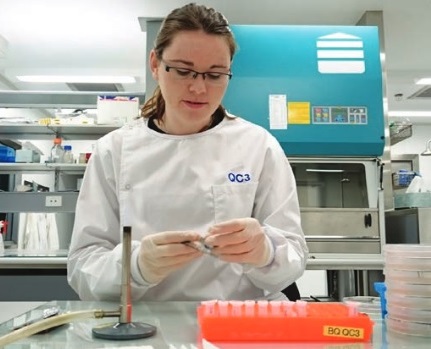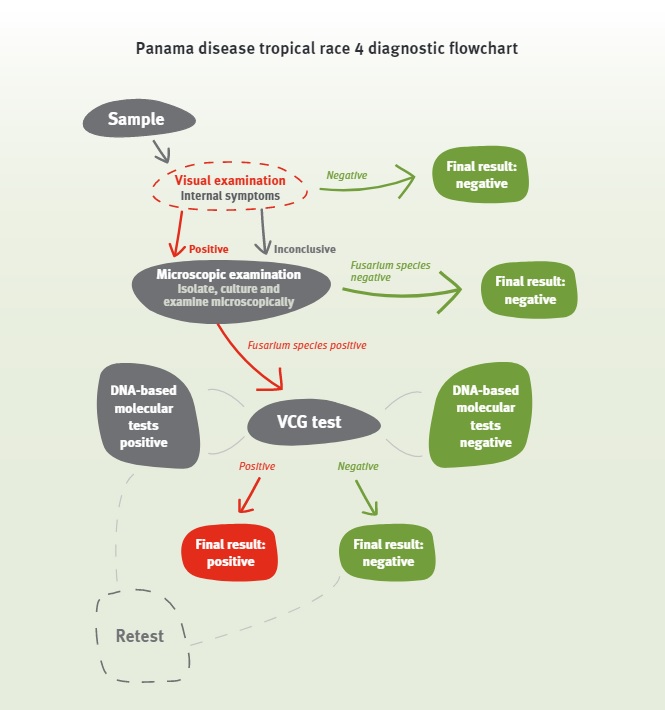
Queensland’s Panama disease testing procedures have been confirmed as being accurate and reliable with two independent laboratories verifying the local program’s results and findings.
Panama TR4 Program leader Rebecca Sapuppo said the Royal Botanic Gardens laboratory in Sydney, and Stellenbosch University in South Africa had conducted their own tests of suspect samples taken from the known infected banana farm near Tully and arrived at the same uniformly positive results.
“Both laboratories are internationally recognised for their research into Fusarium, the group of fungi which includes the Panama disease tropical race 4 pathogen,” she said.
“While there was never any doubt about our 2015 positive detection of the disease at the Tully site, what these independent results do is support our testing approach,” she said.
“It reinforces that Biosecurity Queensland’s plant diagnostic laboratory is at the forefront of diagnostics in Australia, and that we have the ‘gold standard’ laboratory practices in the identification of Panama disease tropical race 4.
“Since March 2015, our laboratory team has examined more than 1400 suspect plant samples for Panama disease tropical race 4.”
Ms Sapuppo said testing for the disease was a highly-complex process.
“To help industry and growers better understand the science behind the disease diagnosis, we have produced a fact sheet that explains the laboratory processes involved,” she said. “The identification of Panama disease tropical race 4 in banana plants requires a range of tests conducted independently of each other. It is quite a lengthy and involved process to reach a positive or negative test result.
“There is growing international interest in the Program’s laboratory procedures and diagnostic tests, especially as our team found one widely-accepted molecular test was not always consistent.
“The world is now looking to Australia for best practice identification, diagnostic testing and laboratory procedures in the detection of Panama disease tropical race 4.
“We are combining our knowledge and experience to assist Far North Queensland banana growers in the fight against this disease.”
How Panama disease tropical race 4 is identified
If external or internal symptoms are consistent with Panama disease tropical race 4, samples are taken from the suspect plant.
Samples are packaged and sent to the laboratory in Brisbane for testing.
The samples are examined in the laboratory by diagnostic specialists.
When the sample is dissected and signs of the disease are present or suspected, the fungus is then cultured and examined under a microscope to determine if it belongs to the fungal group that causes Panama disease tropical race 4.
Additional tests then determine if the fungus is the Panama disease tropical race 4 pathogen or another strain of the pathogen.
A conclusive diagnosis may take several weeks.
More information on the diagnostic process is provided below.
Diagnostic testing for Panama disease tropical race 4
Diagnostic testing for Panama disease tropical race 4 is undertaken by a dedicated diagnostic team, including highly qualified plant pathologists, molecular biologists and laboratory personnel, in the Department of Agriculture and Fisheries’ high level containment laboratory in Brisbane.
The laboratory operates under strict quality management systems to ensure that the highest diagnostics standards are met.
To identify Panama disease tropical race 4, a number of different tests are required before a final diagnosis can be made. A reliable and confident diagnosis requires a body of evidence that is gathered from a clearly defined suite of tests and does not rely on a single test or one type of test. These tests may take a number of weeks to complete.
The diagnostic team will be looking for the tropical race 4 strain of Panama disease, which is caused by the pathogen Fusarium oxysporum f. sp. cubense tropical race 4.
Types of tests
Visual examination
A visual assessment of plants by field officers and laboratory staff is conducted to identify signs of the disease on or inside the plant, including:
External symptoms – diseased plants are detected in the field by trained surveillance officers and field plant pathologists. Officers look for plants with leaf yellowing, wilting and stem splitting indicative of the disease.
Internal symptoms – these symptoms can be seen in the field and in plant material sent to the laboratory.
When the stem or corm of the banana plant is cut, a reddish-brown discolouration is clearly visible in infected tissue.
Microscopic examination
The fungus is grown on selective culture media in the laboratory.
Culture plates are incubated and, after a number of days, the fungal colonies which grow on these plates are examined under the microscope to determine if they belong to the group of fungi known to cause Panama disease tropical race 4. Any suspect fungi growing on these plates are subjected to further laboratory tests.
DNA-based molecular test – PCR (polymerase chain reaction)
Several rapid, sensitive and specific molecular tests are used on purified fungal cultures to identify the fungus.
The definitive molecular test used is DNA sequencing.
Two genes are sequenced, Intergenic Spacer (IGS) and Elongation Factor (EF), which have markers specific to the ‘tropical’ race 4 strain of Panama disease.
Additionally, two PCR tests are conducted simultaneously, to determine firstly if the isolates are Fusarium oxysporum and secondly if it is the tropical or subtropical race 4 strain of Panama disease that is present.
Results from the suite of molecular tests used for Panama disease tropical race 4 diagnostics should consistently match the final VCG results, providing a high level of confidence in the range of testing used and the results obtained.
The two PCRs have been published in peer reviewed journals, the IGS and EF sequencing are also internationally accepted for identifying variation and pathogenic forms within Fusarium and Fusarium oxysporum.
Biological test – VCG (vegetative compatibility group)
The tropical race 4 strain of the fungus which causes Panama disease can be identified in the laboratory by a simple biological test referred to as the VCG test.
Samples of the fungus which have been cultured are grown in the laboratory alongside reference tester strains of the fungus to see if they are the same (compatible) strain.
The test is conducted using the same purified culture which is used for the molecular tests.
Testing of soil and water
There are no diagnostic tests currently available to detect Panama disease tropical race 4 directly from infested soil or water.
Research is being carried out in this area and information will be provided as soon as it is available.
Individual test results
The diagnostic test results which are generated can fall into three categories: positive, negative and inconclusive.
A positive test result means the test has worked well, and that the part of the pathogen being tested for is present.
A negative test result means the test has worked well, and that the part of the pathogen being tested for is not present.
An inconclusive test result is one that is not clearly positive or negative. Inconclusive test results mean that the sample requires further testing.
Diagnosis of Panama disease tropical race 4
Biosecurity Queensland requires a positive test result from VCG testing before confirming that Panama disease tropical race 4 is present in a sample.
VCG testing takes four to six weeks and DNA-based molecular testing is done to provide a preliminary diagnosis.
The requirement for positive results from VCG and molecular testing ensures the accuracy of a positive final result.
Biosecurity Queensland considers a sample to be negative for Panama disease tropical race 4 if it does not show visible symptoms in the field and laboratory or if the fungus cannot be isolated.
If the fungal organism is isolated and both VCG and DNA-based molecular tests for Panama disease tropical race 4 are negative, the sample is negative for the disease.
Having negative results from the suite of tests ensures the accuracy of a negative final result.
Notification of results
Once all test results are available, a Biosecurity Queensland officer will call the grower directly to advise them of the diagnosis, which will also be confirmed via a formal letter and diagnostic report. If the result is positive, the officer will advise the grower of the steps which will need to be taken to ensure control and containment.


